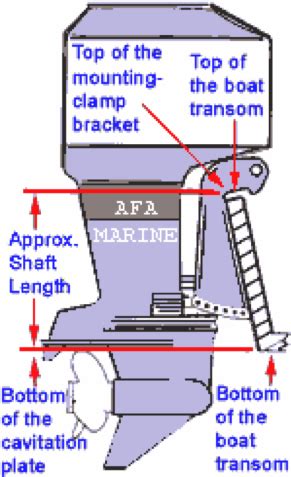Finding the Perfect Fit: Outboard Motor Shaft Length
Choosing the right outboard motor is crucial for a safe and enjoyable boating experience. One of the most critical, yet often overlooked, specifications is the shaft length. Getting this wrong can lead to poor performance, damage to your boat, or even dangerous situations. This comprehensive guide will help you understand outboard motor shaft lengths and how to select the perfect fit for your boat.
What is Outboard Motor Shaft Length?
The shaft length refers to the distance from the bottom of the outboard motor's cavitation plate (the flat plate at the bottom of the lower unit) to the top of the anti-ventilation plate (a small plate near the prop). This measurement is critical because it dictates how deeply the propeller sits in the water. An incorrectly chosen shaft length will impact efficiency and potentially cause damage.
How to Determine the Correct Shaft Length for Your Boat?
Determining the correct shaft length involves careful measurement and consideration of several factors:
-
Transom Height: This is the most important factor. The transom is the back of your boat where the motor mounts. Measure the distance from the bottom of the boat's transom to the waterline. This measurement should be taken with the boat fully loaded and at the waterline you'll typically operate at.
-
Boat Type: Different boat types require different shaft lengths. Shallow-draft boats, such as jon boats or some aluminum fishing boats, generally need shorter shafts. Larger, deeper-hulled boats typically need longer shafts.
-
Motor Size and Weight: Heavier motors might require slightly different shaft lengths for optimal performance and trim.
-
Intended Use: The type of boating you'll be doing influences the choice. Fishing in shallow waters requires a shorter shaft, while cruising in deeper water might need a longer one.
Common Shaft Lengths:
Most outboard motors come in standard shaft lengths, typically measured in inches:
- Short (15"): Suitable for very shallow draft boats.
- Regular (20"): The most common length, fitting a wide range of boats.
- Extra Long (25"): Used for boats with deeper transoms.
- Extra Long (30"): Required for very deep-hulled boats.
Measurement Process:
- Prepare Your Boat: Ensure your boat is fully loaded to its normal operating weight.
- Measure the Transom: Carefully measure the distance from the bottom of the transom to the waterline. Use a reliable measuring tape and take multiple measurements to ensure accuracy.
- Consult the Manufacturer's Specifications: Your boat's manufacturer should provide transom height specifications and recommended outboard motor shaft length. This is crucial information that will guide your choice.
- Consult with a Marine Professional: If you are unsure about the correct shaft length, consult with a qualified marine mechanic or boat dealer. They can provide expert advice and ensure you make the right decision.
What happens if I choose the wrong shaft length?
- Too Short: The propeller might vent (come out of the water), leading to reduced performance, cavitation (loss of power), and potential damage to the motor.
- Too Long: The propeller might be too deep in the water, causing excessive drag and reducing fuel efficiency. It could also cause damage to the propeller or lower unit if it hits submerged objects.
Frequently Asked Questions
How do I measure transom height accurately?
Accuracy is key. Ensure your boat is at its normal operating weight, and measure from the bottom of the transom to the waterline with the boat floating freely. Take multiple measurements to ensure consistency.
Can I use a longer shaft than recommended?
While you might be able to physically mount a longer shaft, it's generally not recommended. The propeller will be too deep, causing drag, inefficient performance, and potential damage to the lower unit.
What if I don't know my boat's transom height?
Check the boat's manufacturer's specifications or contact the manufacturer directly. You can also consult a marine dealer or mechanic for assistance.
Can a boat mechanic help determine the correct shaft length?
Yes, a qualified marine mechanic is a valuable resource. They can inspect your boat, assess its transom height, and recommend the appropriate shaft length based on your needs and boat type. Their expertise will ensure you get the perfect fit.
Choosing the correct outboard motor shaft length is crucial for optimal performance, safety, and longevity of your boat and motor. By carefully following the measurement process and consulting with professionals if needed, you can ensure you select the perfect fit and enjoy many hours of trouble-free boating. Remember to always prioritize safety and consult with experts when in doubt.

